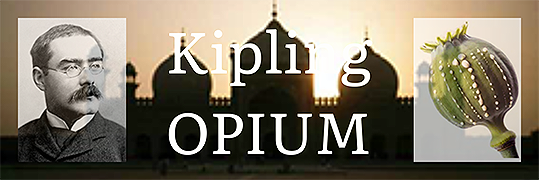Kipling Opium
In an Opium Factory
Young Kipling based in Lahore, India, 1884
Joseph Rudyard Kipling, 1865 – 1936, was born in British India and returned there after school in England, landing at Bombay in October 1882. A four-day railway journey took him to Lahore where his father had arranged a job for him as assistant editor of a local newspaper, the Civil and Military Gazette.
The Gazette printed Kipling’s journalism as well as his verses and stories. His writing showed promise and gained attention. The Gate of the Hundred Sorrows, 1884, is set in an opium house and provided the first tale in Plain Tales from the Hills, 1888.
The tale is presented as a monologue by Gabral Misquitta, an opium addict, six weeks before his death. It describes the life of the opium den, and of the opium smokers, in the Coppersmith's Gully near the mosque of Wazir Khan, Lahore. In the end, all life for them revolves around the 'black smoke.' Kipling uses the visual simile of ‘chasing the dragon’ which was an old Hong Kong expression for opium smoking.
Kipling took opium as a blocker for his semi-permanent Delhi Belly and as a sedative to help him sleep through the hot nights; though he often wandered the back streets of Lahore in the early hours.
In An Opium Factory - an essay in technical journalism
Published 16th April, 1888, in the Pioneer, Allahabad, and afterwards suppressed by Kipling who omitted it from his Collected Works. The article came to light only in 2007, in an attic discovery. It is reproduced here with notes.
Ghazipur Opium Factory
An earlier blog post on Jim Thompson mentioned opium and Kipling. The opium did not come from a back street dealer:
medicinal opium sold under the generic name Paregoric or Laudanum.
Steve Mongkut 2023




